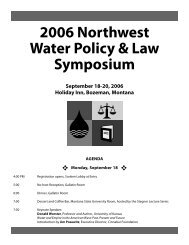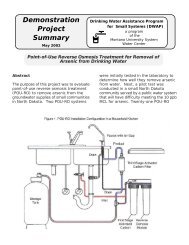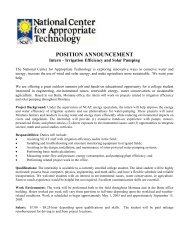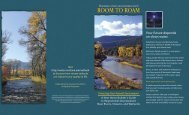aquaculturehealth - Montana Water Center - Montana State University
aquaculturehealth - Montana Water Center - Montana State University
aquaculturehealth - Montana Water Center - Montana State University
Create successful ePaper yourself
Turn your PDF publications into a flip-book with our unique Google optimized e-Paper software.
withdrawal period leaves producers with ample marketing<br />
flexibility.<br />
“Aquaflor® has proved to be safe and highly effective, with good<br />
palatability, so we have high hopes for it in the US aquaculture<br />
industry,” said Dr Patricia Gaunt, associate professor, aquatic<br />
animal health with the Mississippi <strong>State</strong> <strong>University</strong> College of<br />
Veterinary Medicine.<br />
In tank trials conducted at the university, catfish fingerlings<br />
challenged with ESC had a cumulative death rate of only 0.8<br />
percent, compared with 60 percent for challenged, untreated fish.<br />
In the same study, treated fingerlings showed an infection rate of<br />
only 1.7 percent, compared with 72.3 percent for untreated<br />
controls.<br />
Palatability trials show that fish consume feed medicated with<br />
Aquaflor® at the same rate as unmedicated feed - even when<br />
Aquaflor® was used at 10 times the recommended dose rate.<br />
Aquaflor® has been used to treat fish species around the world<br />
since the early 1990s. Its first introduction was in Japan for use in<br />
yellowtail and other local species, and it was subsequently<br />
introduced in Europe, Canada and Chile for treating furunculosis<br />
in salmon.<br />
Additional approvals have been granted or are anticipated over<br />
the next several months in Latin American and Far Eastern<br />
countries for shrimp and species of finfish such as tilapia.<br />
Additional claims and indications are also being sought in Europe.<br />
See www.spaquaculture.com and www.aquaflor-usa.com.<br />
(Aquaflor and NUFLOR are registered trademarks of the<br />
Schering-Plough Veterinary Corporation)<br />
MOROCCO: BONAMIA OSTREAE<br />
OUTBREAK UPDATE<br />
Details of the final report, submitted to the OIE by the Animal<br />
Production Department, Ministry of Agriculture and Rural<br />
Development, Rabat, on the outbreak of Bonamia ostreae in<br />
farmed flat oysters (Ostrea edulis) in Laayoune Province, can be<br />
accessed via the Aquatic Animals Commission website.<br />
See www.oie.int/aac/eng/en_fdc.htm<br />
PACIFIC ISLANDS: MODEL IMPORT RISK<br />
ANALYSIS (IRA) FRAMEWORK DEVELOPED<br />
(Source: Jean-Paul Gaudechoux, Fisheries Information Adviser,<br />
Secretariat of the Pacific Community, New Caledonia,<br />
e-mail jeanpaulg@spc.int)<br />
The Aquaculture Section has engaged a team of international<br />
consultants to undertake two import risk<br />
analyses (IRAs) involving the proposed<br />
introduction of aquatic species. The team, led<br />
by J Richard Arthur, included Melba Bondad-<br />
Reantaso, Edward Lovell, David Hurwood and<br />
Peter Mather.<br />
The risk analyses were developed to serve as<br />
models for consideration by other Pacific Island<br />
countries for future translocations. The IRA<br />
process can significantly reduce the risks<br />
associated with translocation that might occur<br />
from a poorly planned and executed<br />
introduction or some unanticipated result. This<br />
is a valuable tool for implementing proper biosecurity<br />
measures, and constitutes a best<br />
practice approach for quarantine and<br />
translocation.<br />
The IRA process formulated for the Pacific<br />
has two approaches. Unlike the traditional<br />
approach, which focuses on pathogenic<br />
diseases, the model framework for the Pacific<br />
includes both a pathogen and an ecological risk<br />
LARVAL MACROBRACHRIUM ROSENBERGII CULTURE AT THE<br />
MINISTRY OF FISHERIES AND FORESTRY AQUACULTURE CENTRE,<br />
NADURULOULOU, FIJI<br />
analysis. The ecological component recognises the high value<br />
attributed to biodiversity in the Pacific.<br />
The pathogen risk analysis examines the potential risks due to<br />
pathogen introduction, along with the movement of the<br />
commodity, identifies hazards (pathogens) requiring further<br />
consideration, and recommends ways to reduce the risk of<br />
introduction to an acceptable level. The analysis was conducted<br />
using a qualitative approach with six risk categories (high,<br />
moderate, low, very low, extremely low, negligible).<br />
The ecological risk analysis focuses on the invasiveness and<br />
“pest potential” of the species to be translocated, and considers<br />
the likelihood of its escape and/or release into the natural<br />
environment, and the nature and extent of any potential ecological<br />
impacts that could stem from escape or release. To assist in<br />
assessing the ecological risks, a questionnaire and decision-making<br />
process was used.<br />
The first risk analysis concerned the introduction of blue<br />
shrimp (Litopenaeus stylirostris) from Brunei Darussalam to Fiji.<br />
See the SPC’s website<br />
www.spc.int/aquaculture/ site/publications/ documents/<br />
Stylirostris_BruneiFiji.pdf<br />
A second, separate report analysed the risk associated with the<br />
proposed introduction of giant river prawn (Macrobrachium<br />
rosenbergii) from Fiji to the Cook Islands.<br />
See www.spc.int/aquaculture/ site/publications/documents/<br />
Macrobrachium Rosenbergii1.pdf<br />
■<br />
PRAWN FARM LOCATED IN NAVUA,<br />
OUTSIDE OF SUVA, FIJI<br />
FEBRUARY 2006 AQUACULTURE HEALTH INTERNATIONAL 13






